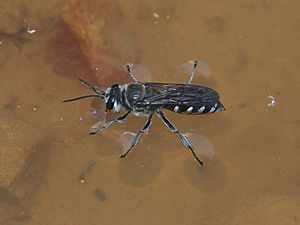Pison facts for kids
Quick facts for kids Pison |
|
|---|---|
 |
|
| A wasp of the genus Pison gathering water for nest construction. | |
| Scientific classification | |
| Kingdom: | |
| Phylum: | |
| Class: | |
| Order: | |
| Family: |
Crabronidae
|
| Subfamily: |
Crabroninae
|
| Tribe: |
Trypoxylini
|
| Genus: |
Pison
Spinola 1808
|
| Species | |
|
See text |
|
Pison is a type of wasp found all over the world. These wasps belong to a family called Crabronidae. There are about 145 different kinds, or species, of Pison wasps that scientists have already named. But there might be many more that haven't been discovered yet, especially in South America.
Contents
Where Pison Wasps Live
Pison wasps live in warm parts of the world. You can find them in tropical and warm temperate areas. They don't usually live in very cold northern places.
Most Pison species live in the Southern Hemisphere. About one-third of all known Pison wasps live in Australia. Scientists think that these wasps used to be found in more places. But over time, other types of wasps might have competed with them. This could be why Pison wasps are now mostly found in areas that are a bit more isolated.
Some Pison wasps build their nests in small spaces. These can be holes in wood, keyholes, or other similar spots. Because of this, some species have traveled far and wide. They have spread to new places by hitching rides on ships and aircraft. For example, P. argentatum and P. iridipenne have been moved around by humans for a very long time. It's hard to know where they originally came from!
Life Cycle and What Pison Wasps Eat
Pison wasps have a unique way of feeding their young. Adult female wasps hunt for living spiders. They sting the spiders to make them paralyzed, but not dead. This means the spiders can't move, but they stay fresh.
The female wasp then lays an egg on one or more of these paralyzed spiders. She seals the spiders and her egg inside a special chamber she builds. When the wasp larva hatches from the egg, it has a fresh meal waiting for it. The larva eats the spider, then changes into a pupa, and finally emerges as an adult wasp from the chamber.
How Pison Wasps Build Nests
Many Pison wasp species build large nests out of mud. They often choose sheltered places like caves or hollow trees. Other species are more creative. They use natural holes they find. These can be hollow plant stems, burrows made by beetles, or even old bird nests. Some Pison wasps even dig their own tunnels for nesting.
Inside a larger nest structure, a female wasp will create several small cells. Each cell holds a paralyzed spider and one egg. She seals off each cell from the others using mud or even dung pellets. This helps make sure that each young wasp has enough food and doesn't have to compete with its siblings.
Types of Pison Wasps
The group of Pison wasps is very diverse. Scientists have studied them for a long time. At one point, the Pison genus was divided into smaller groups called subgenera. But now, scientists often group them into "species groups" instead. These groups help researchers understand the relationships between the many different kinds of Pison wasps.
As of 2018, there are many accepted species of Pison wasps. Some of these species are only known from fossils, meaning they lived a very long time ago!

